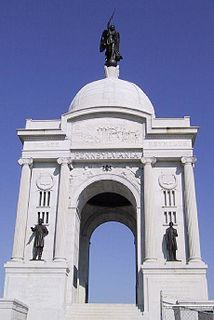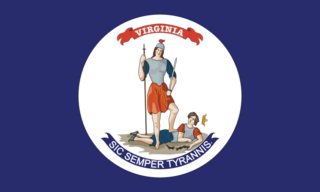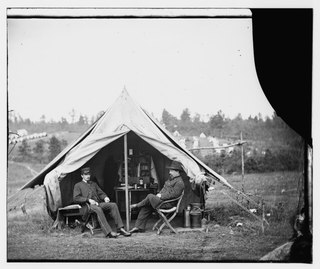
The Battle of Gettysburg was fought July 1–3, 1863, in and around the town of Gettysburg, Pennsylvania, by Union and Confederate forces during the American Civil War. In the battle, Union Major General George Meade's Army of the Potomac defeated attacks by Confederate General Robert E. Lee's Army of Northern Virginia, halting Lee's invasion of the North. The battle involved the largest number of casualties of the entire war and is often described as the war's turning point due to the Union's decisive victory and concurrence with the Siege of Vicksburg.

The National Civil War Museum, located at One Lincoln Circle at Reservoir Park in Harrisburg, Pennsylvania, is a permanent, nonprofit educational institution created to promote the preservation of material culture and sources of information that are directly relevant to the American Civil War of 1861–1865, and the aftermath period of the war as related to Civil War Veterans' service organizations, including the Grand Army of the Republic, United Confederate Veterans and the Daughters of the Confederacy to 1920. The museum also serves as the National Headquarters for the Sons of Union Veterans of the Civil War (SUVCW), the legal successor to the Grand Army of the Republic (GAR). In 2009, the museum became affiliated with the Smithsonian Institution in Washington, D.C.

Edwin Cole Bearss was a historian of the American Civil War, tour guide, and United States Marine Corps veteran of World War II.
The American Battlefield Trust is a charitable organization whose primary focus is in the preservation of battlefields of the American Civil War, the Revolutionary War and the War of 1812 through acquisition of battlefield land. The American Battlefield Trust was formerly known as the Civil War Trust. On May 8, 2018, the organization announced the creation of the American Battlefield Trust as the umbrella organization for two divisions, the Civil War Trust and the Revolutionary War Trust, which was formerly known as "Campaign 1776."

The Civil War: A Narrative (1958–1974) is a three volume, 2,968-page, 1.2 million-word history of the American Civil War by Shelby Foote. Although previously known as a novelist, Foote is most famous for this non-fictional narrative history. While it touches on political and social themes, the main thrust of the work is military history. The individual volumes include Fort Sumter to Perryville (1958), Fredericksburg to Meridian (1963), and Red River to Appomattox (1974).

Buildings, sites, districts, and objects in Virginia listed on the National Register of Historic Places:
Company D, 2nd Virginia Infantry, locally designated the Berkeley Border Guards, was an antebellum Virginia militia company and then a company of the 2nd Virginia Infantry, a Confederate infantry unit during the American Civil War.
Harrisburg, Pennsylvania, during the American Civil War, was the capital of the second largest state in the Union. Located at the intersection of important railroads, Harrisburg was an important supply and logistics center for the dissemination and transportation of materiel for Northern armies. Tens of thousands of new recruits were mustered into service and/or drilled at a series of Harrisburg-area United States Army training camps, including the sprawling Camp Curtin. Confederate forces under Lieutenant General Richard S. Ewell threatened Harrisburg during the June 1863 Gettysburg Campaign, but did not launch any serious efforts to take the city due to being recalled towards Gettysburg by General Robert E. Lee. Pennsylvania Governor Andrew Curtin ordered local workers to erect a series of forts and earthworks to protect the city of 13,000 residents.

The 11th Virginia Infantry Regiment was an infantry regiment raised in Virginia for service in the Confederate States Army during the American Civil War. It fought mostly with the Army of Northern Virginia.
Keith Rocco is a military and historical painter working in the United States.

The 28th Virginia Infantry Regiment was an infantry regiment raised in Virginia for service in the Confederate States Army during the American Civil War. It fought mostly with the Army of Northern Virginia. The 28th Virginia completed its organization at Lynchburg, Virginia, in June, 1861. Its members were raised in the counties of Botetourt, Craig, Bedford, Campbell, and Roanoke.

Round Top is a populated place in the U.S. state of Pennsylvania, near Little Round Top. It is notable for two Battle of Gettysburg hospitals, the 1884 Round Top Station, and several battlefield commemorative era attractions such as Round Top Park and the Round Top Museum. The unincorporated community lies on an elevated area of the north-south Taneytown Road with 3 intersections at Blacksmith Shop Road to the northeast, Wheatfield Road, and Sachs Road.

The 9th Virginia Cavalry Regiment was a cavalry regiment raised in Virginia for service in the Confederate States Army during the American Civil War. It fought mostly with the Army of Northern Virginia.

The Gettysburg Museum and Visitor Center is a Gettysburg National Military Park facility, with a museum about the American Civil War, the 1884 Gettysburg Cyclorama, and the tour center for licensed Battlefield Guides and for buses to see the Gettysburg Battlefield and Eisenhower National Historic Site.

Braehead is a historic house located in Fredericksburg, Virginia. The 6,000 square foot house was built in 1858-1859 by George Mullen for John Howison, born in Fredericksburg, Virginia, in 1809. John Howison's sister was the now-famous Civil War diarist, Jane Briggs Beale.

The commemoration of the American Civil War is based on the memories of the Civil War that Americans have shaped according to their political, social and cultural circumstances and needs, starting with the Gettysburg Address and the dedication of the Gettysburg cemetery in 1863. Confederates, both veterans and women, were especially active in forging the myth of the Lost Cause of the Confederacy.

The 72nd New York Infantry Regiment was one of five infantry regiments formed by former U.S. Congressman Daniel Sickles and established as part of the Excelsior Brigade which fought with the Union Army during multiple key engagements of the American Civil War, including the Chancellorsville Campaign in Virginia, the Battle of Gettysburg in Pennsylvania, and the Overland Campaign. Leaders from the 72nd New York recruited men from New Jersey, as well as from cities and small towns across the State of New York.
The Civil War Trust's Civil War Discovery Trail is a heritage tourism program that links more than 600 U.S. Civil War sites in more than 30 states. The program is one of the White House Millennium Council's sixteen flagship National Millennium Trails. Sites on the trail include battlefields, museums, historic sites, forts and cemeteries.
Alexander John Marshall was a Virginia lawyer, businessman and politician who served many years as Clerk of Fauquier County, helped secure construction of the Rappahannock Canal, and was a Virginia state senator during the American Civil War (1862–1865).

Allen Wilson Greene, also known as Will Greene, is an American historian, author, and retired museum director. Greene was the director of the Association for the Preservation of Civil War Sites. Later, he became director of Pamplin Historical Park and the National Museum of the Civil War Soldier in Petersburg, Virginia. He also served on the national oversight board for the Institute of Museum and Library Services Over the years, Greene has made ten appearances on C-SPAN.













